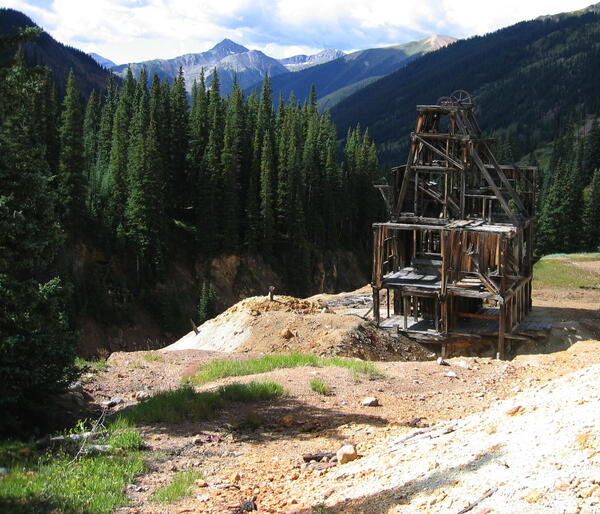Sample of eudialyte (pink) within layered vein consisting of quartz, albite, and sodic amphibole, Dora Bay, Alaska. Size of sample is 11 by 9 cm. Sample of coarse-grained, tabular bastnäsite within matrix of ferruginous dolomite, Birthday Claim, Mountain Pass, California. Photographs by Philip Verplanck, U.S. Geological Survey. SIR 2010-5070-J
Philip L Verplanck
Philip Verplanck is a Research Geologist with the Geology, Geophysics, and Geochemistry Science Center.
Science and Products
Source, transport and deposition of critical minerals using trace metal and isotope systematics: Denver High Resolution Laboratory
Evaluation of Critical Elements in Carbonatites
Non-Traditional Stable Isotopes
Critical Elements in Carbonatites: From Exploration Targets to Element Distribution
Fluids in Rare Earth Element (REE) Ore Genesis
Geochemical data for carbonatite samples from the Mountain Pass rare earth element deposit, southeast California
Strontium isotopic data from the Mount Emmons-Redwell area, Crested Butte, Colorado
Whole rock major, minor, and trace element geochemistry of the upper part of the Mount Emmons-Redwell porphyry molybdenum (Climax-type) deposit, Redwell Basin, Crested Butte, Colorado
Geochemical data for the Elk Creek alkaline complex, southeast Nebraska
Geochemical analyses of surface water, groundwater and springs surrounding Mount Emmons near Crested Butte, Colorado (ver. 2.0, September 2020)
Whole-rock geochemical data for the Bear Lodge alkaline complex, Wyoming: 2009 - 2013
Ferricrete, manganocrete, and bog iron occurrences with selected sedge bogs and active iron bogs and springs in the upper Animas River watershed, San Juan County, Colorado
Sample of eudialyte (pink) within layered vein consisting of quartz, albite, and sodic amphibole, Dora Bay, Alaska. Size of sample is 11 by 9 cm. Sample of coarse-grained, tabular bastnäsite within matrix of ferruginous dolomite, Birthday Claim, Mountain Pass, California. Photographs by Philip Verplanck, U.S. Geological Survey. SIR 2010-5070-J

The Silver Ledge Mine in the area of upper Mineral Creek, near Silverton, Colorado, is one of many abandoned mine sites in the watershed.
The Silver Ledge Mine in the area of upper Mineral Creek, near Silverton, Colorado, is one of many abandoned mine sites in the watershed.
The Mount Weld rare earth element deposit, Western Australia: A carbonatite-derived laterite
Carbonatite-hosted rare earth element (REE) deposits are the primary source of the world’s light REEs and have the potential to be a source of heavy REEs. The Mount Weld REE deposit in Western Australia is hosted in a lateritic sequence that reflects supergene enrichment of the underlying carbonatite complex. Similar to other carbonatite-related ore deposits, ore from Mount Weld displays extreme l
The truth is in the stream: Use of tracer techniques and synoptic sampling to evaluate metal loading and remedial options in a hydrologically complex setting
Cathodoluminescence response of barite at room and liquid nitrogen temperatures
Petrogenesis and rare earth element mineralization of the Elk Creek carbonatite, Nebraska, USA
Book review: Rare earth element resources: Indian context
Rare earth element deposits in China: A review and new understandings
A 20-year record of water chemistry in an alpine setting, Mount Emmons, Colorado, USA
Aluminum mobility in mildly acidic mine drainage: Interactions between hydrobasaluminite, silica and trace metals from the nano to the meso-scale
Rare earth element mineral deposits in the United States
The ~1.85 Ga carbonatite in north China and its implications on the evolution of the Columbia supercontinent
Strategic and critical metals in produced geothermal fluids from Nevada and Utah
Cinnamon gulch revisited: Another look at separating natural and mining-impacted contributions to instream metal load
Science and Products
Source, transport and deposition of critical minerals using trace metal and isotope systematics: Denver High Resolution Laboratory
Evaluation of Critical Elements in Carbonatites
Non-Traditional Stable Isotopes
Critical Elements in Carbonatites: From Exploration Targets to Element Distribution
Fluids in Rare Earth Element (REE) Ore Genesis
Geochemical data for carbonatite samples from the Mountain Pass rare earth element deposit, southeast California
Strontium isotopic data from the Mount Emmons-Redwell area, Crested Butte, Colorado
Whole rock major, minor, and trace element geochemistry of the upper part of the Mount Emmons-Redwell porphyry molybdenum (Climax-type) deposit, Redwell Basin, Crested Butte, Colorado
Geochemical data for the Elk Creek alkaline complex, southeast Nebraska
Geochemical analyses of surface water, groundwater and springs surrounding Mount Emmons near Crested Butte, Colorado (ver. 2.0, September 2020)
Whole-rock geochemical data for the Bear Lodge alkaline complex, Wyoming: 2009 - 2013
Ferricrete, manganocrete, and bog iron occurrences with selected sedge bogs and active iron bogs and springs in the upper Animas River watershed, San Juan County, Colorado
Sample of eudialyte (pink) within layered vein consisting of quartz, albite, and sodic amphibole, Dora Bay, Alaska. Size of sample is 11 by 9 cm. Sample of coarse-grained, tabular bastnäsite within matrix of ferruginous dolomite, Birthday Claim, Mountain Pass, California. Photographs by Philip Verplanck, U.S. Geological Survey. SIR 2010-5070-J
Sample of eudialyte (pink) within layered vein consisting of quartz, albite, and sodic amphibole, Dora Bay, Alaska. Size of sample is 11 by 9 cm. Sample of coarse-grained, tabular bastnäsite within matrix of ferruginous dolomite, Birthday Claim, Mountain Pass, California. Photographs by Philip Verplanck, U.S. Geological Survey. SIR 2010-5070-J

The Silver Ledge Mine in the area of upper Mineral Creek, near Silverton, Colorado, is one of many abandoned mine sites in the watershed.
The Silver Ledge Mine in the area of upper Mineral Creek, near Silverton, Colorado, is one of many abandoned mine sites in the watershed.
The Mount Weld rare earth element deposit, Western Australia: A carbonatite-derived laterite
Carbonatite-hosted rare earth element (REE) deposits are the primary source of the world’s light REEs and have the potential to be a source of heavy REEs. The Mount Weld REE deposit in Western Australia is hosted in a lateritic sequence that reflects supergene enrichment of the underlying carbonatite complex. Similar to other carbonatite-related ore deposits, ore from Mount Weld displays extreme l






